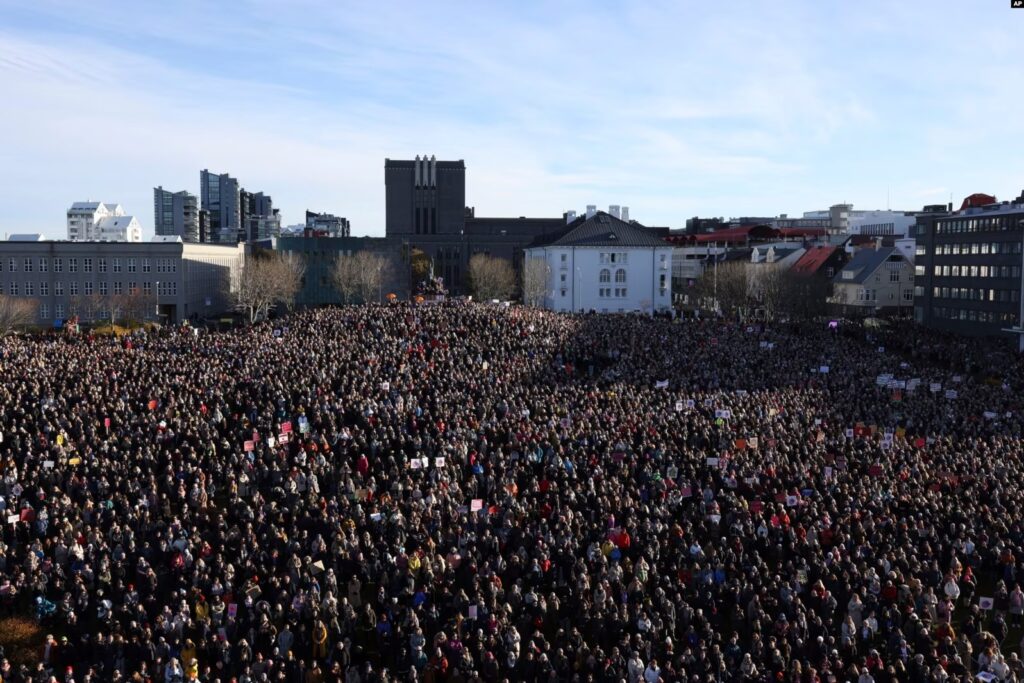The women of the world’s number one performer on gender equality went on strike on Tuesday, stopping paid and unpaid work to protest gender inequality and continuing violence against women.
From 2pm until 8pm at night, tens of thousands of Icelandic women participated in the Women’s Day off, including the country’s prime minister Katrín Jakobsdóttir, with workplaces closing or operating on skeleton staff and unpaid care and domestic work being left to men to sort out.
The protest has sparked global attention and much curiosity regarding whether other countries could or would ever follow the lead.
But one of the more significant questions asked is why women in Iceland – which has led the World Economic Forum’s Gender Equality Index for 14 years in a row – would be protesting gender inequality?
Iceland is a world leader on paid parental leave. It has great childcare and an education system that is much more flexible to working parents than other countries. It boasts an impressive figure of almost nine in ten working-age women having jobs. It was the first country in the world to get a female president. Almost 50 per cent of its MPs are women, and it celebrates impressive results for women in business leadership. According to the WEF, it has closed 90 per cent of its gender gaps.
But Iceland still has a gender pay gap – recorded at 10.2 per cent in 2021, and the pay gap rises substantially across certain industries, to almost 30 per cent in banking and finance. It faces similar issues to Australia on pay, with those in care roles continuing to be undervalued and underpaid, as well as gender pay gaps rising to much bigger figures when you consider total remuneration packages – such as by factoring in bonuses and other salary payments, as the Workplace Gender Equality Agency records across businesses in Australia.
Rates of violence against women and girls are high in Iceland, with one in four women reporting they had been raped or sexually assaulted in a 2018 survey.
Also, with Iceland being celebrated as a gender equality paradise globally, the organisers of the strike shared that they must lead by example and keep working to close the gaps. Just because you do better than other countries doesn’t mean the work that’s left to do should go ignored.
The organisers also know that progress achieved on gender equality can quickly go backwards and that there is no room or time for complacency.
Indeed, Prime Minister Jakobsdóttir recently noted how she is seeing achieved progress falling behind on the world stage – with a decline in female leadership globally. She described being a woman at the top as “a lonely pace”.
Also worth considering is the historical context of women’s strikes in Iceland, and the role they had is seeing the country become a gender equality leader. In 1977, an incredibly 90 per cent of the country’s women staged a walkout, refusing to cook, clean and look after children. Accounts of that day describe how the country came to a standstill, factories closed, and fathers were lost on how to feed their children.
Why does Iceland continually take the No. 1 sport on the World Economic Forum’s Gender Equality Index?
Iceland is a tiny country with a population of less than a million people. But according to the World Economic Forum, it leads the rest of the world on gender equality. Why?
First and foremost, Iceland has a history of firsts for women — including becoming the first in the world to grant equal inheritance rights to men and women back in 1850.
In 1975, Icelandic women famously came up with the concept of “Woman’s Day Off” to protest the lack of representation for women in politics and labour force participation.
Then Iceland elected the world’s first female leader, Vigdís Finnbogadóttir, who became President in 1980 and served for 16 years. It appointed its first female prime minister Jóhanna Sigurðardóttir in 2009.
Iceland was also the first country in the world to enforce equal pay in 2018, laws which require companies employing more than 25 people to be certified as paying equal wages for equal value — or face daily fines.
Another powerful mechanism Iceland has is based on Equal Status and Equal Rights Irrespective of Gender, enacted in 2000 “to prevent discrimination on the basis of gender and to maintain gender equality and equal opportunities for the gender in all spheres of society.” This mechanism has since been revamped and modernised, it defines various areas of gender discrimination and offers a roadmap to achieving gender equality.
Iceland has a 40 per cent quota for company boards, a law passed in 2010 which came into effect in 2013. The law followed the Global Financial Crisis in 2009, which resulted in protests and demonstrations across the country — and the start of a new progressive government. They prosecuted those involved and also concluded that a key cause of the crash was the male-dominated business culture and economy.
Also contributing to Iceland’s status is its world-leading paid parental leave and childcare system. In Iceland, both parents (mothers and fathers) are given four weeks of paid parental leave, paid at their replacement wage — with provisions adjusted for single parents. Families are then offered an additional two months of paid leave, which they can determine how to split.
Overall, and as Tuesday’s 2023 strike showed — almost 50 years since their first and most famous Women’s Day Off — Iceland won’t stop at good enough, or even best globally. It will continue to push to completely close its gender gaps.


